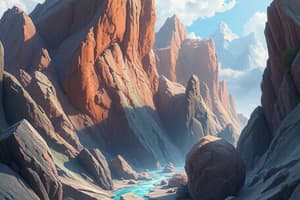Podcast
Questions and Answers
What type of rock forms at or near the surface of the Earth by cementing together of loose grains?
What type of rock forms at or near the surface of the Earth by cementing together of loose grains?
Sedimentary Rock
What do the open spaces between particles in sedimentary rocks preserve?
What do the open spaces between particles in sedimentary rocks preserve?
Coal, Natural Gas, Oil, and H2O
What is a Clastic Sedimentary Rock made of?
What is a Clastic Sedimentary Rock made of?
Cemented-together solid fragments and grains derived from preexisting rocks
What do Biochemical Sedimentary Rocks consist of?
What do Biochemical Sedimentary Rocks consist of?
What type of rock consists of carbon-rich remains of once living organisms?
What type of rock consists of carbon-rich remains of once living organisms?
What defines Chemical Sedimentary Rocks?
What defines Chemical Sedimentary Rocks?
What is the process by which sediment is transformed into solid rock?
What is the process by which sediment is transformed into solid rock?
What is cementation in sedimentary rocks?
What is cementation in sedimentary rocks?
What does weathering refer to in the context of sedimentary rock formation?
What does weathering refer to in the context of sedimentary rock formation?
What is erosion?
What is erosion?
What refers to the movement of sediment by wind, water, or ice?
What refers to the movement of sediment by wind, water, or ice?
What is deposition in relation to sedimentary rocks?
What is deposition in relation to sedimentary rocks?
The size of clasts in sedimentary rocks is defined as the diameter of the clasts making up the rock, with gravel being greater than ____ mm.
The size of clasts in sedimentary rocks is defined as the diameter of the clasts making up the rock, with gravel being greater than ____ mm.
Match the sediment sizes with their descriptions:
Match the sediment sizes with their descriptions:
Flashcards are hidden until you start studying
Study Notes
Sedimentary Rocks Overview
- Form at or near Earth's surface through processes such as cementing, precipitation of minerals, accumulation of shell fragments, or growth of shell-producing organisms.
Storage Potential
- Pore spaces in sedimentary rocks are crucial for storing resources like Coal, Natural Gas, Oil, and Water.
Types of Sedimentary Rocks
- Clastic Sedimentary Rock: Forms from cemented rock fragments (clasts) derived from preexisting rocks.
- Biochemical Sedimentary Rocks: Composed of shell sediments from once living organisms; includes cemented shells that accumulate post-mortem.
- Organic Sedimentary Rocks: Made up of carbon-rich remains derived from plant life.
- Chemical Sedimentary Rocks: Consist of minerals that crystallize directly from water solutions.
Formation Processes
- Weathering: Involves the breakdown of rocks into detritus through physical and chemical processes.
- Erosion: A combination of processes that detach and transport rock or regolith from its original substrate.
- Transportation: Involves the movement of sediment by wind, water, or ice.
- Deposition: The process where sediment settles out from the transporting medium.
Lithification and Cementation
- Lithification: Transformation of loose sediment into solid rock, aided by the pressure from overlying materials that expel water and air.
- Cementation: Involves minerals like quartz and calcite precipitating from groundwater and filling in spaces between clasts.
Clast Size Classification
- Gravel (Conglomerate): Clast diameter > 2mm
- Sand (Sandstone): Clast diameter between 2mm - 1/16mm, visible to the naked eye.
- Silt (Siltstone): Clast diameter between 1/16mm - 1/256mm, not visible to the naked eye.
- Clay (Claystone): Clasts too small to be seen without magnification.
Studying That Suits You
Use AI to generate personalized quizzes and flashcards to suit your learning preferences.





